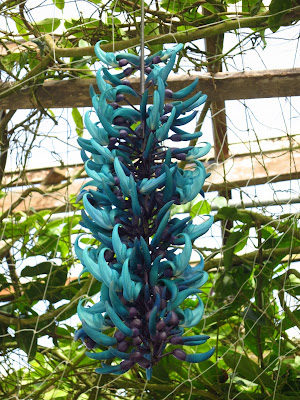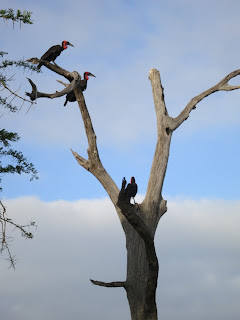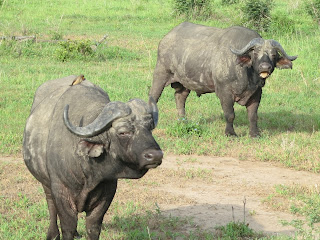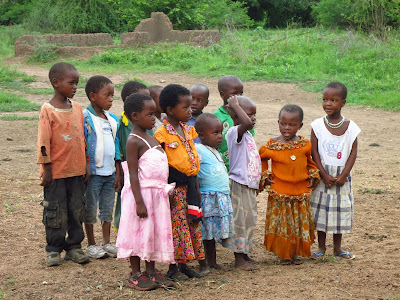Our driver dropped us off as close as
you can get by car, and the brother of the bungalow owner met us on
his motorbike to escort us (and, more importantly, to transport our
luggage) up the long, narrow road to the inn. We were outwardly impressed
by his navigation of the incredibly steep paths, which he managed
gracefully even while toting both of our large packs on his bike.
When we arrived, we were completely
overwhelmed by the beauty and serenity of the place, and thrilled
that we were fortunate enough to be spending the next few days there.
Even just the walk to the bungalow left us feeling as though we had
entered some sort of dream world—the type of place you only see in
movies. We were shown to our room—a humble 10x10 thatch-roofed
abode which sits at the very top of the facility and looks down on
the rooftops of most of the town. We relaxed there for a few minutes
before climbing the steep stairs back down to the restaurant to get
something to eat.
We chose this destination for one
reason: the orangutans. As soon as we learned that these incredible
animals—with whom we share 96.4% of our genes—live in Sumatra, we
knew we had to try and visit them. Sumatra is one of two places left
on earth where orangutans still live (the other is Borneo), and sadly
their habitat in both places is getting smaller by the day. Though
both the Bornean and Sumatran orangutans (considered to be two
separate species) are endangered, and the Sumatran orangutans are
even “critically endangered”, an estimated 9520 acres of the
jungle in which they live is cut down each day to be replaced by a
palm oil plantation or a rubber tree farm. That comes out to about 6
football fields worth of their lush, green habitat every minute.
The increasingly high demand on these two products, or on products
which contain palm oil or rubber, has created an all too familiar
situation: certain people placing a higher value on the development
and commodification of the forest here, than they do on the unique
plant and animal species which inhabit it. In short, there's a lot
more money to be made on palm oil and rubber, than there is on saving
the orangutans, or the countless other things that live in, and can
only be found in, the Sumatran jungle. Sadly, the majority of us are
blind to what's going on, or regularly choose convenience over
compassion and activism.
Palm
oil is used for all sorts
of things. We cook with it, wash ourselves with it, paint our faces
with it, even fuel our cars with it (that's right, the supposedly “greener” biodiesel
is often made with palm oil). Anything that comes in a wrapper almost certainly contains it. We didn't use it hardly at all 60 years
ago, but now we can't seem to manage without it. “Why?”
you might ask. Because it's cheaper
for companies to use palm oil than any of the other ingredients which
can easily be used in it's place. Although they are the ones deciding
to take the more cost-efficient, less sustainable route, it's us, the
consumers who are enabling them by purchasing their products. The
harsh truth is that with every purchase you make of an item
containing palm oil, you are feeding the demand for more plantations,
and by association, contributing to the destruction of more
rainforest, and the killing of the creatures which inhabit it.
The tragic fact of what's happening in places like Sumatra and Borneo was proven entirely too true to us as we made the drive to Bukit
Lawang from Medan. We passed virtually nothing but
palm oil plantations. Rows and rows of palm trees—as far as the eye
could see— and every last one of them planted in a spot where there
used to be precious rainforest. We were both overwhelmed with sadness
for the continuing loss of such a beautiful environment—an
ecosystem which is so rare, and from which such beauty grows.
Please, consider becoming more informed on this important subject by clicking HERE before reading on.
We
were fortunate enough to see a female orangutan our first afternoon
from the deck of the bungalow restaurant. She was hanging out in a
tree just above the bank of the river on the opposite side from us,
and she was stunning.
One of the employees pointed her out to us and we watched in awe as
she swung about, feeding on different branches. She moved confidently from tree to tree, captivating us with her strength and gracefulness. We
continued observing her while enjoying our own lunches, and then
headed down to the riverbank to get a closer look.
We sat watching her
for nearly an hour, unable to tear our eyes off this incredible
creature, who looked and moved so much like us, yet in a way unlike
any creature we'd seen before. Orangutans have adapted to have especially long fingers and limbs, which significantly help them to achieve such impressive arboreal locomotion. They spend most of their lives up in trees, making them extremely skilled at climbing and navigating between branches. They are also highly intelligent—the average adult orangutan's intelligence is comparable to that of a six year old human child. Eventually we decided to head up to
our room—we had scheduled a trek for the following day and had many
more animals to see in the morning!
We set off with our
guide bright and early after a hearty breakfast. He knew tons about
the flora and fauna of the jungle and stopped often to point out an
animal or bring our attention to the call of a particular bird. He
told us all about the medicinal uses of plants that we passed, and
often offered us a taste of ones that were edible. It's hard to so
much as pass through such an environment and not be impressed by it's
diversity and natural bounty. We were continually astonished by the
wealth of plants and their broad spectrum of uses. As we stared into
the deep, tangled green on either side of the trail, it wasn't
difficult to imagine the possibility of things growing here that no
one has ever discovered.
An
hour or so into our eight hour trek we spotted our first primates of
the day—a couple of white-handed gibbons (a small species of ape)
bouncing around the tops of the trees. We scurried down a hillside,
pulled out our binoculars and tried to get a good view of them as
they darted quickly from branch to branch. As we sat straining to
catch a glimpse through the leaves, our guide pointed out some other
animals—macaque monkeys—a few of which were swinging in some
trees nearby. We stood gazing up at them, high above us in the
branches. At one point we found ourselves looking directly up and
were caught off guard when our guide hurriedly warned us of the “hot
shower” we were about to receive. Sure enough, we ducked out of the
way just in time to
avoid getting peed on by a full-bladdered gibbon that was passing
overhead. All three of us stood in the middle of the trail laughing
hysterically at our extremely close call, which of course scared the
monkeys away, so we continued on.
Mid-way through the
morning, our guide led us to one of several orangutan feeding
platforms that are scattered throughout the park. The rangers
occasionally offer the orangutans supplementary food at these
specific locations, and so, he told us, it would be more likely for
us to find one there (hoping for an easy snack, no doubt). Sure
enough, as we approached, we came across a small group of people
gathered watching, and just beyond them, a very special sight indeed:
a beautiful mother orangutan with her new baby in tow.
Our
guide told us they were very familiar with this particular orangutan,
and that her baby had been born only ten days ago under the watchful
eyes of some of the park rangers. He explained that they don't use
tracking devices, but rather that the guides and rangers often
recognize many of the
different orangutans in the park by their facial features.
We continued
watching the pair for quite a while, in awe of her strength and
dexterity as she flowed from tree to tree, and amazed at the tiny
baby's ability to hold on to his mother's side through every stretch
and swing. We learned that one of the things that makes population
recovery difficult for these wonderful, endangered creatures is the
especially long length of their birthing cycles. Though their
gestation is the same as ours—9 months—a young orangutan will
stay with his mother for six to eight years learning everything he
needs to know to survive on his own. Mother orangutans can only
manage to feed and teach one baby at a time, and thus only have
another once the previous has “left the nest”.
To our
surprise, this 'new mom' seemed to feel quite safe and unfazed by the
presence of the growing group of people gathering to watch her and
her little one, and we were able to get incredibly close. At several
points, she even moved towards
us
in her attempt to reach a different tree. When this would happen, the
guides would ask us to calmly back away, and do our best to maintain
at least a couple of meters of space between her and us.
Once we'd had our
fill (and felt like she deserved some space) we left her to munch on
her leaves, and continued on our trek. After a while longer, we
stopped along the trail and enjoyed a traditional Indonesian packed
lunch—fried rice with veggies and an egg wrapped in banana leaves.
To top it off, our guide had brought along a variety of jungle fruits
for dessert, some of which we had never seen or even heard of before.
Later in the
afternoon, we ran into another group of macaques. There were quite a
few of them scampering all through the trees and on the ground around
us. We hung out for a while, enjoying their antics.
As our trek was
nearing it's end, we came upon one final species of primate—the
Thomas Leaf monkey. There was a large group of them playing in the
trees and making quite a ruckus just near the edge of the park. We
loved their “David Beckham” mohawks and the little white rings around
their eyes.
Despite our
exhaustion from the long day in the park, we were reluctant to leave
when the time came. We felt as though we could spend months exploring
and still not feel ready to go. We knew there were still more animals
to spot, more plants to taste, more sights to behold—but sadly, the
day was coming to an end, and our time was up.
We left feeling a
renewed and even stronger desire to fight for and protect this
extraordinary place, with its diverse inhabitants and unparalleled
beauty. That being the case, we want to strongly urge you, our
readers, to take action—however small—against the atrocities
being committed by short sighted corporations that are motivated by
greed. Avoid buying products containing palm oil whenever
possible, and research carefully before purchasing rubber
products as well. Do your due diligence and READ the LABEL before
you buy! The orangutans, and
other jungle residents don't stand a chance if we don't take action
now. If nothing else, I want this beautiful place to still be there
for future generations to experience like we did.
~Jenna





















































